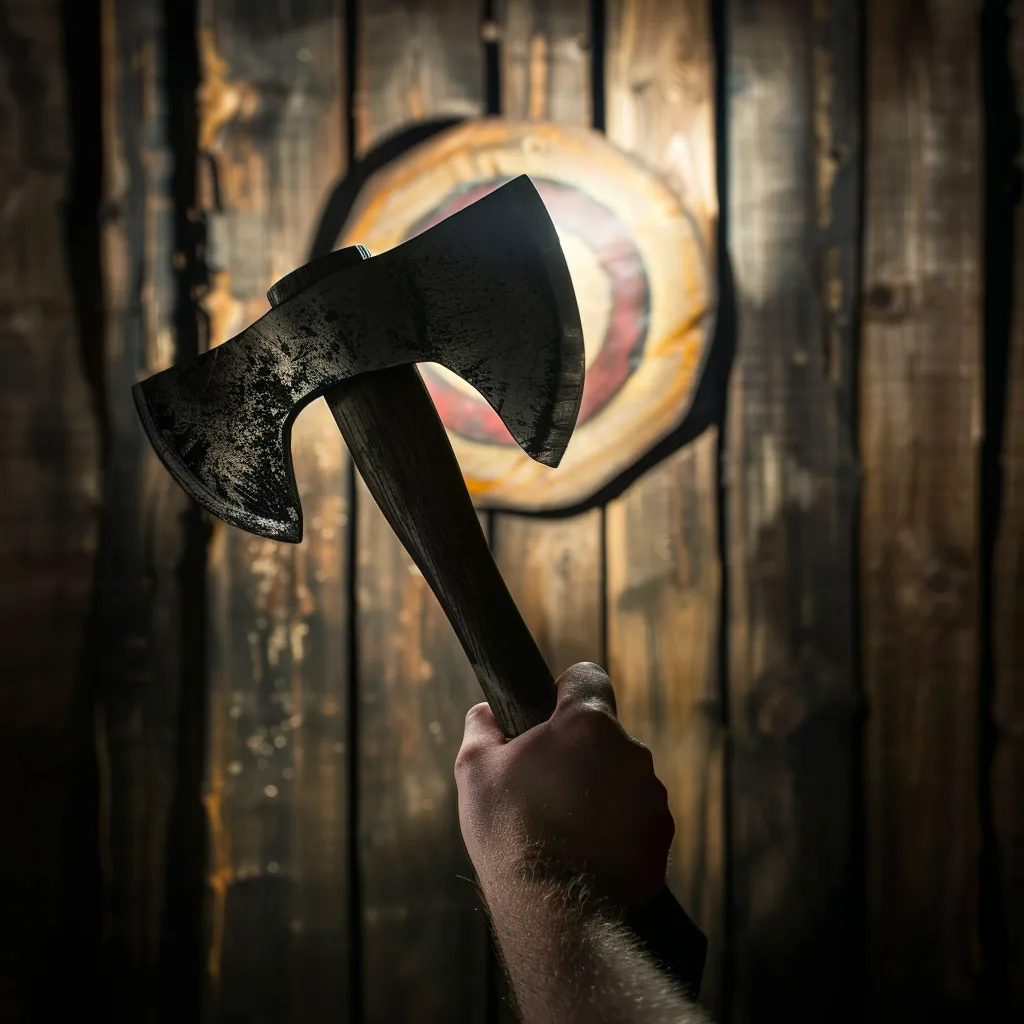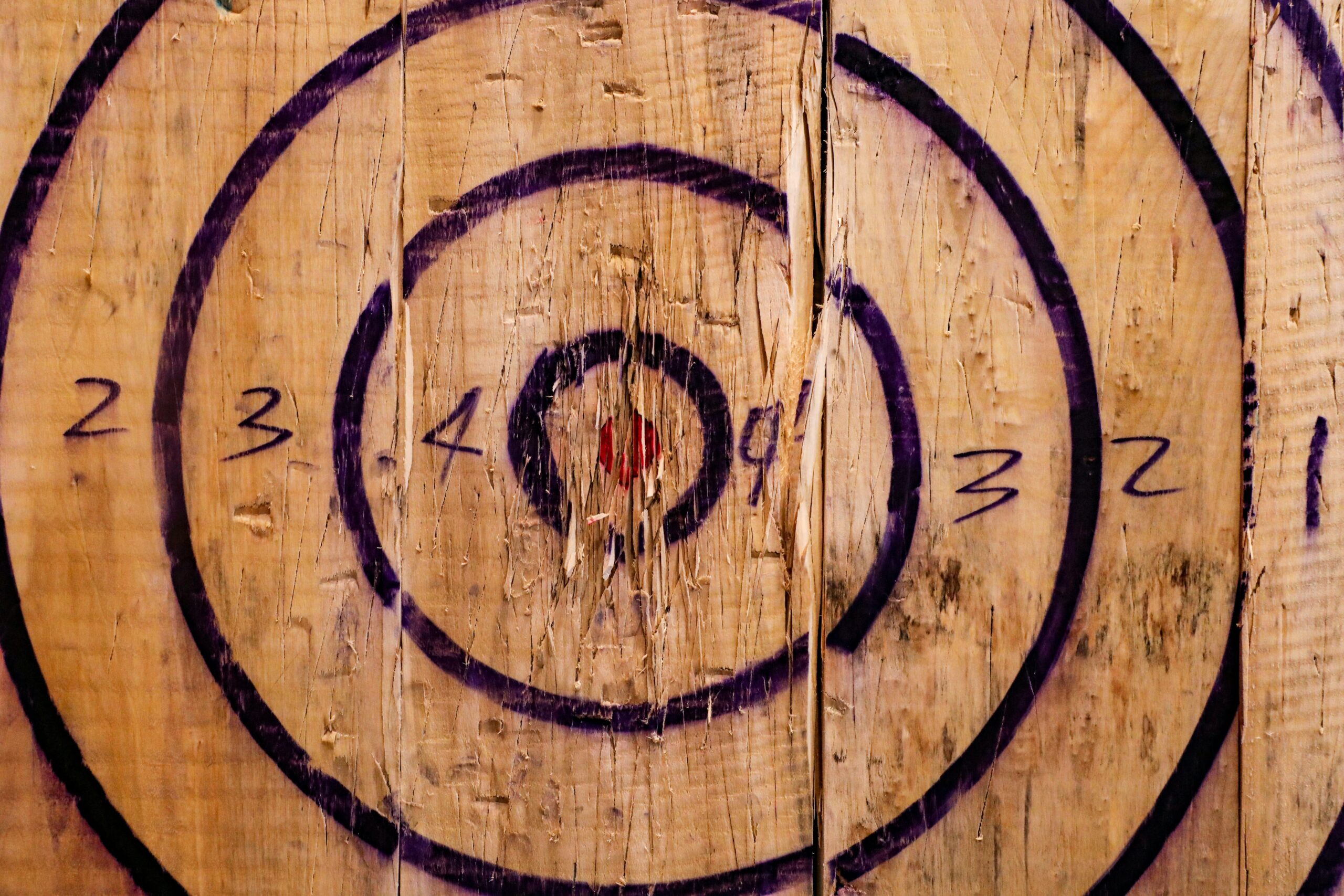Are you struggling to hit the target consistently when axe throwing? Mastering your axe-throwing stance is crucial for accuracy and precision in this sport. This guide will cover foot positioning, grip techniques, and body alignment to enhance your throwing skills. You’ll learn practical tips to improve your stability, control, and overall performance. By the end, you’ll have the knowledge to refine your stance and boost your chances of hitting the bullseye with every throw.
Key Takeaways
- Proper stance impacts throwing accuracy, relying on weight distribution, body alignment, and foot positioning
- Consistent grip technique is crucial for better control and precision in axe throwing
- Core engagement and proper breathing techniques enhance stability and improve overall throwing performance
- Regular practice and feedback tools help develop consistency and refine axe throwing technique
- Adapting techniques for different axe types and integrating mental focus improve precision in axe throwing
Understanding the Fundamentals of Axe Throwing Stance

Understanding the fundamentals of axe throwing stance is crucial for enhanced precision. A solid stance impacts throwing accuracy, relying on proper finger placement, body height, and muscle memory.
This section explores key elements of a strong stance, including weight distribution and carbon steel axe handling. Common posture mistakes to avoid will also be covered, helping throwers refine their technique.
Why Your Stance Impacts Throwing Precision
The stance in axe throwing plays a crucial role in achieving precision. A stable stance ensures proper weight distribution, enabling throwers to maintain balance throughout the throwing motion, which directly affects the accuracy of the release and allows for consistent delivery of the steel throwing axe.
Additionally, body alignment improves control and aim, while correct foot positioning provides stability for an accurate release. By focusing on these elements, you can enhance your overall performance and improve your chances of hitting the target with greater precision.
Key Elements of a Solid Axe Throwing Stance
A solid axe-throwing stance involves several key elements. The thrower’s feet should be shoulder-width apart, with the dominant foot slightly forward. Maintaining a balanced posture, the thrower should angle their body slightly towards the target. The hatchet should be held at eye level, allowing for a clear line of sight. This positioning helps maintain control and accuracy throughout the throw.
Common Posture Mistakes to Avoid
Axe throwers often make posture mistakes that hinder their performance in the World Axe Throwing League. Common errors include leaning too far forward or backward, which affects the motion and rotation of the axe.
Throwers may also tense their shoulders or grip the blade too tightly, reducing control and accuracy. By avoiding these mistakes and focusing on a balanced stance, throwers can improve their chances of hitting the bullseye consistently.
Positioning Your Feet for Optimal Stability

Proper foot positioning is crucial for stability in axe throwing. This section explores determining the best foot placement, aligning feet with the target, and adjusting for varying distances. By focusing on these elements, throwers can enhance their experience and accuracy, whether throwing at wood targets up close or from afar. Mastering foot positioning is key to developing a solid foundation for precise axe throwing.
Determining the Best Foot Placement for You
Determining the best foot placement for axe throwing requires experimentation and practice. Throwers should start with their feet shoulder-width apart, aligning their dominant foot with the center of the target.
The wrist position and grip on the axe handle play crucial roles in maintaining stability during throwing attempts. Adjusting foot placement can help throwers find their optimal stance for wielding the weapon effectively.
- Stand with feet shoulder-width apart
- Align dominant foot with target center
- Experiment with foot positioning
- Consider wrist and grip position
- Practice to find an optimal stance
Aligning Your Feet With the Target
Aligning feet with the target is a crucial skill in axe throwing. Throwers should position their feet shoulder-width apart, with their dominant foot slightly forward. The length of the stance and the attention to thumb placement on the axe handle contribute to overall stability. By focusing on proper alignment, throwers can improve their accuracy and consistency, enhancing their ability to hit the target with precision.
Adjusting Foot Position for Varying Distances
Adjusting foot position for varying distances is essential in axe throwing. Throwers must modify their stance to account for changes in trajectory as the distance to the target increases or decreases. For longer distances, a wider stance and a more pronounced forward lean can help generate additional power. Conversely, shorter distances may require a more compact stance. The grip on the carbon axe handle and arm positioning should also be adjusted accordingly to maintain control and accuracy across different throwing ranges.
Mastering the Grip for Better Control

Mastering the grip is crucial for better control in axe throwing. This section explores selecting the right grip technique, ensuring consistency, and understanding the connection between grip and accuracy. By focusing on these elements, throwers can improve their control and precision, enhancing their overall performance in axe-throwing competitions and practice sessions.
Selecting the Right Axe Grip Technique
Selecting the right axe grip technique is essential for better control in axe throwing. Throwers should experiment with different grips to find the one that feels most comfortable and provides the best control. The most common grip involves placing the dominant hand near the axe head, with the thumb and index finger forming a “V” shape around the handle. This grip allows for precise control and a smooth release, enhancing accuracy and consistency in throws.
Ensuring a Consistent Grip Every Time
Ensuring a consistent grip every time is crucial for axe-throwing accuracy. Throwers should develop a routine for gripping the axe handle, focusing on finger placement and pressure. Practice helps build muscle memory, allowing throwers to replicate their grip consistently. A consistent grip leads to more predictable throws and improved overall performance. Key elements of a consistent grip include:
- Hand position on the handle
- Finger placement and pressure
- Wrist alignment
- Grip tightness
- Pre-throw grip check
The Connection Between Grip and Accuracy
The connection between grip and accuracy in axe throwing is significant. A proper grip allows throwers to control the axe’s rotation and trajectory, leading to more precise throws. The way a thrower holds the axe affects its release point and spin, which directly impacts where it lands on the target. Consistent grip pressure and finger placement enable throwers to replicate successful throws, improving their overall accuracy and performance in competitions.
Aligning Your Body for Maximum Accuracy

Aligning the body is crucial for maximum accuracy in axe throwing. This section explores proper shoulder and hip alignment, core engagement, and breathing techniques. These elements work together to enhance stability and precision. By mastering these aspects, throwers can improve their overall performance and consistency in hitting the target.
Maintaining Proper Shoulder and Hip Alignment
Maintaining proper shoulder and hip alignment is crucial for axe-throwing accuracy. Throwers should keep their shoulders and hips parallel to the target, creating a stable base for the throw. This alignment allows for a smooth, controlled motion and helps direct the axe toward the target with precision. Proper alignment also reduces the risk of injury and improves overall throwing consistency.
The Role of Core Engagement in Your Throw
Core engagement plays a vital role in axe-throwing precision. A strong, engaged core stabilizes the body during the throw, allowing for better control and accuracy. Throwers should focus on tightening their abdominal muscles throughout the throwing motion, maintaining a stable torso that serves as an anchor for the arm movement. This engagement helps transfer power from the lower body to the upper body, resulting in a more consistent and powerful throw. Key benefits of core engagement in axe throwing include:
- Improved stability during the throw
- Enhanced power transfer from lower to upper body
- Increased control over the axe’s trajectory
- Better balance throughout the throwing motion
- Reduced risk of injury due to proper form
Breathing Techniques to Enhance Stability
Proper breathing techniques enhance stability in axe throwing. Throwers should take a deep breath before initiating the throw, holding it briefly to stabilize their core. As they release the axe, they should exhale smoothly, maintaining control throughout the motion. This controlled breathing helps reduce tension, improves focus, and contributes to a more consistent throwing technique.
Conclusion
Mastering your axe-throwing stance is crucial for achieving enhanced precision and consistency in this challenging sport. A solid stance forms the foundation for accurate throws, incorporating proper foot positioning, grip technique, body alignment, and mental focus.
Regular practice allows enthusiasts to refine their technique and adapt to different axe types. Axe throwers can significantly improve their performance by integrating physical skills with mental preparation.

